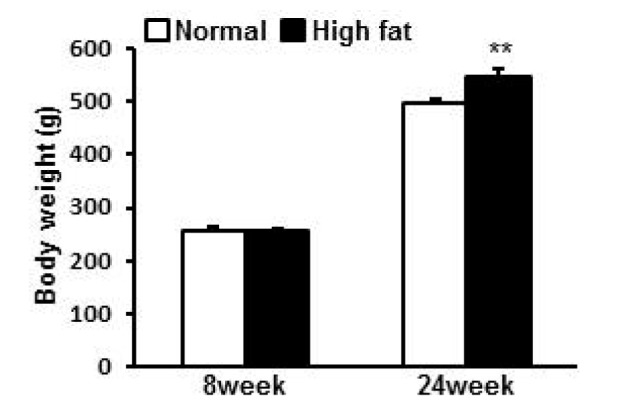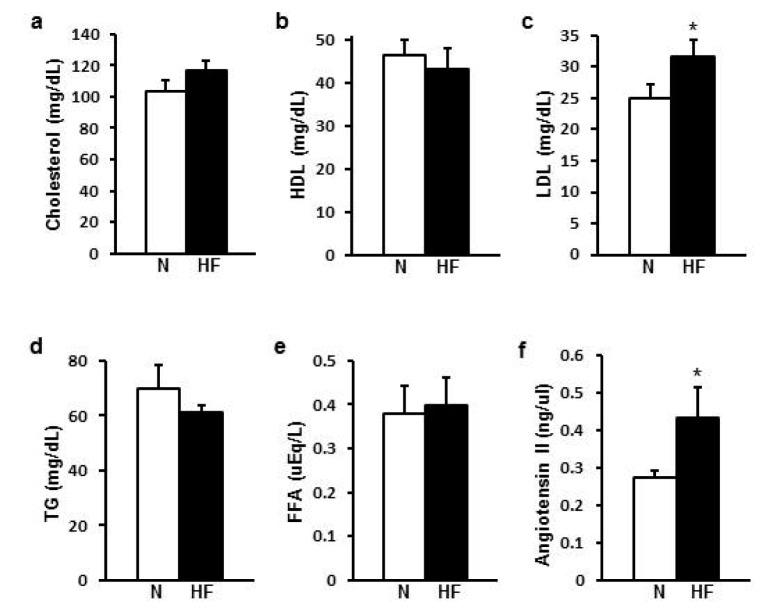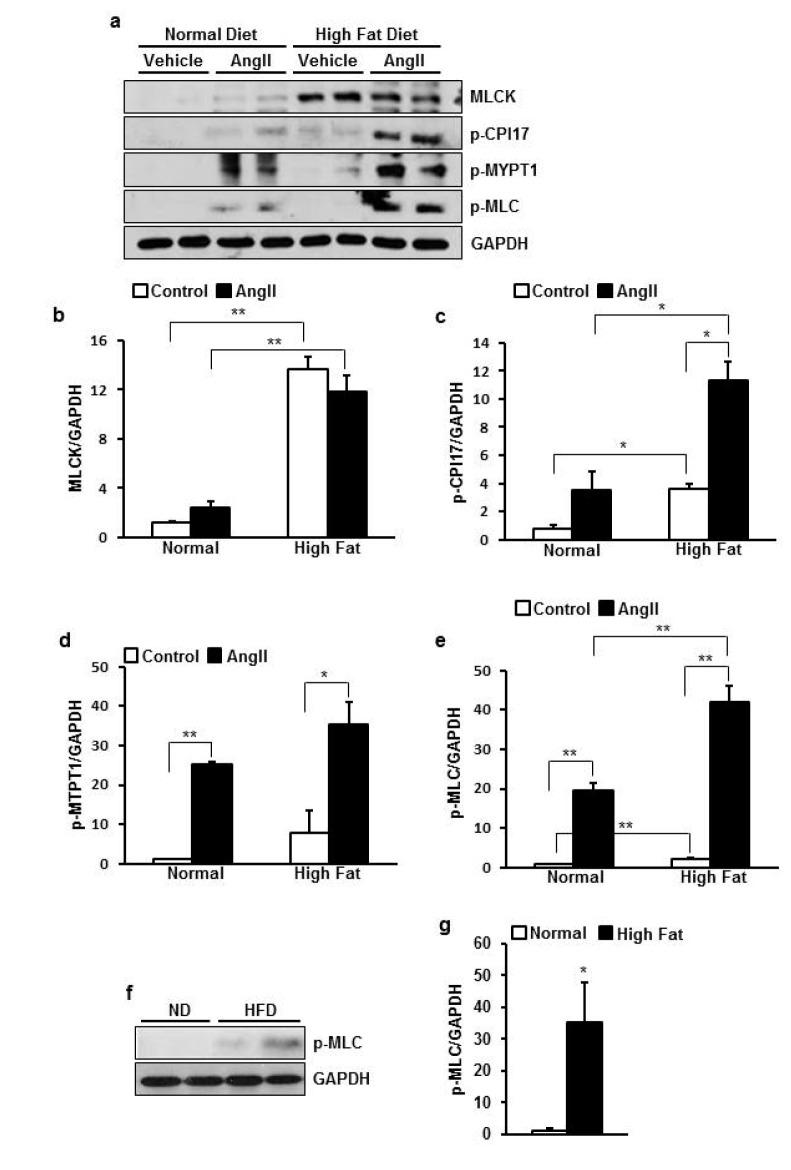Korean J Physiol Pharmacol.
2017 Jan;21(1):99-106. 10.4196/kjpp.2017.21.1.99.
High fat diet confers vascular hyper-contractility against angiotensin II through upregulation of MLCK and CPI-17
- Affiliations
-
- 1Department of Molecular Medicine, Keimyung University School of Medicine, Daegu 42601, Korea. jeein.kim@kmu.ac.kr
- KMID: 2371073
- DOI: http://doi.org/10.4196/kjpp.2017.21.1.99
Abstract
- Obesity is a critical risk factor for the hypertension. Although angiotensin II (Ang II) in obese individuals is known to be upregulated in obesity-induced hypertension, direct evidence that explains the underlying mechanism for increased vascular tone and consequent increase in blood pressure (BP) is largely unknown. The purpose of this study is to investigate the novel mechanism underlying Ang II-induced hyper-contractility and hypertension in obese rats. Eight-week old male Sprague-Dawley rats were fed with 60% fat diet or normal diet for 4 months. Body weight, plasma lipid profile, plasma Ang II level, BP, Ang II-induced vascular contraction, and expression of regulatory proteins modulating vascular contraction with/without Ang II stimulation were measured. As a result, high fat diet (HFD) accelerated age-dependent body weight gaining along with increased plasma Ang II concentration. It also increased BP and Ang II-induced aortic contraction. Basal expression of p-CPI-17 and myosin light chain (MLC) kinase was increased by HFD along with increased phosphorylation of MLC. Ang II-induced phosphorylation of CPI-17 and MLC were also higher in HFD group than control group. In conclusion HFD-induced hypertension is through at least in part by increased vascular contractility via increased expression and activation of contractile proteins and subsequent MLC phosphorylation induced by increased Ang II.
Keyword
MeSH Terms
-
Angiotensin II*
Angiotensins*
Animals
Blood Pressure
Body Weight
Contractile Proteins
Diet
Diet, High-Fat*
Humans
Hypertension
Male
Myosin Light Chains
Obesity
Phosphorylation
Phosphotransferases
Plasma
Rats
Rats, Sprague-Dawley
Risk Factors
Up-Regulation*
Angiotensin II
Angiotensins
Contractile Proteins
Myosin Light Chains
Phosphotransferases
Figure
Cited by 1 articles
-
α-Isocubebene modulates vascular tone by inhibiting myosin light chain phosphorylation in murine thoracic aorta
Byeong Hyeok Ye, Eun Jung Kim, Seung Eun Baek, Young Whan Choi, So Youn Park, Chi Dae Kim
Korean J Physiol Pharmacol. 2018;22(4):437-445. doi: 10.4196/kjpp.2018.22.4.437.
Reference
-
2. Mark AL, Correia M, Morgan DA, Shaffer RA, Haynes WG. State-of-the-art-lecture: Obesity-induced hypertension: new concepts from the emerging biology of obesity. Hypertension. 1999; 33:537–541. PMID: 9931161.3. Goodfriend TL, Calhoun DA. Resistant hypertension, obesity, sleep apnea, and aldosterone: theory and therapy. Hypertension. 2004; 43:518–524. PMID: 14732721.4. Gu P, Xu A. Interplay between adipose tissue and blood vessels in obesity and vascular dysfunction. Rev Endocr Metab Disord. 2013; 14:49–58. PMID: 23283583.
Article5. Uemura K, Mori N. Influence of age and sex on high-fat diet-induced increase in blood pressure. Nagoya J Med Sci. 2006; 68:109–114. PMID: 16967776.6. Davies MR, Gleich K, Katerelos M, Lee M, Mount PF, Power DA. The Thiazide-Sensitive Co-Transporter Promotes the Development of Sodium Retention in Mice with Diet-Induced Obesity. Kidney Blood Press Res. 2015; 40:509–519. PMID: 26418861.
Article7. Vargas-Robles H, Rios A, Arellano-Mendoza M, Escalante BA, Schnoor M. Antioxidative diet supplementation reverses high-fat diet-induced increases of cardiovascular risk factors in mice. Oxid Med Cell Longev. 2015; 2015:467471. PMID: 25922641.
Article8. Boustany-Kari CM, Gong M, Akers WS, Guo Z, Cassis LA. Enhanced vascular contractility and diminished coronary artery flow in rats made hypertensive from diet-induced obesity. Int J Obes (Lond). 2007; 31:1652–1659. PMID: 16819529.
Article9. Wang Y, Song Y, Suo M, Jin X, Tian G. Telmisartan prevents high-fat diet-induced hypertension and decreases perirenal fat in rats. J Biomed Res. 2012; 26:219–225. PMID: 23554752.
Article10. Wirth A, Benyó Z, Lukasova M, Leutgeb B, Wettschureck N, Gorbey S, Orsy P, Horváth B, Maser-Gluth C, Greiner E, Lemmer B, Schütz G, Gutkind JS, Offermanns S. G12-G13-LARG-mediated signaling in vascular smooth muscle is required for salt-induced hypertension. Nat Med. 2008; 14:64–68. PMID: 18084302.
Article11. Brooks DP, Ruffolo RR Jr. Pharmacological mechanism of angiotensin II receptor antagonists: implications for the treatment of elevated systolic blood pressure. J Hypertens Suppl. 1999; 17:S27–S32. PMID: 10465064.12. Hall JE, do Carmo JM, da Silva AA, Wang Z, Hall ME. Obesity-induced hypertension: interaction of neurohumoral and renal mechanisms. Circ Res. 2015; 116:991–1006. PMID: 25767285.13. Kadakol A, Malek V, Goru SK, Pandey A, Bagal S, Gaikwad AB. Esculetin attenuates alterations in Ang II and acetylcholine mediated vascular reactivity associated with hyperinsulinemia and hyperglycemia. Biochem Biophys Res Commun. 2015; 461:342–347. PMID: 25887801.
Article14. Zhang X, Yan SM, Zheng HL, Hu DH, Zhang YT, Guan QH, Ding QL. A mechanism underlying hypertensive occurrence in the metabolic syndrome: cooperative effect of oxidative stress and calcium accumulation in vascular smooth muscle cells. Horm Metab Res. 2014; 46:126–132. PMID: 24108391.
Article15. Savineau JP, Marthan R. Modulation of the calcium sensitivity of the smooth muscle contractile apparatus: molecular mechanisms, pharmacological and pathophysiological implications. Fundam Clin Pharmacol. 1997; 11:289–299. PMID: 9263758.
Article16. Somlyo AP, Somlyo AV. Ca2+ sensitivity of smooth muscle and nonmuscle myosin II: modulated by G proteins, kinases, and myosin phosphatase. Physiol Rev. 2003; 83:1325–1358. PMID: 14506307.17. Margolis M, Perez O Jr, Martinez M, Santander AM, Mendez AJ, Nadji M, Nayer A, Bhattacharya S, Torroella-Kouri M. Phospholipid makeup of the breast adipose tissue is impacted by obesity and mammary cancer in the mouse: Results of a pilot study. Biochimie. 2015; 108:133–139. PMID: 25450252.
Article18. Kim JI, Jung SW, Yang E, Park KM, Eto M, Kim IK. Heat shock augments angiotensin II-induced vascular contraction through increased production of reactive oxygen species. Biochem Biophys Res Commun. 2010; 399:452–457. PMID: 20688045.
Article19. Bray GA. Risks of obesity. Endocrinol Metab Clin North Am. 2003; 32:787–804. PMID: 14711062.
Article20. Soltani Z, Washco V, Morse S, Reisin E. The impacts of obesity on the cardiovascular and renal systems: cascade of events and therapeutic approaches. Curr Hypertens Rep. 2015; 17:7. PMID: 25620635.
Article21. Dharmarajan TS, Dharmarajan L. Tolerability of Antihypertensive Medications in Older Adults. Drugs Aging. 2015; 32:773–796. PMID: 26442857.
Article22. Abraham HM, White CM, White WB. The comparative efficacy and safety of the angiotensin receptor blockers in the management of hypertension and other cardiovascular diseases. Drug Saf. 2015; 38:33–54. PMID: 25416320.
Article23. Curb JD, Schneider K, Taylor JO, Maxwell M, Shulman N. Antihypertensive drug side effects in the Hypertension Detection and Follow-up Program. Hypertension. 1988; 11:II51–II55. PMID: 3350594.
Article24. Massiéra F, Bloch-Faure M, Ceiler D, Murakami K, Fukamizu A, Gasc JM, Quignard-Boulange A, Negrel R, Ailhaud G, Seydoux J, Meneton P, Teboul M. Adipose angiotensinogen is involved in adipose tissue growth and blood pressure regulation. FASEB J. 2001; 15:2727–2729. PMID: 11606482.
Article25. Cooper R, McFarlane-Anderson N, Bennett FI, Wilks R, Puras A, Tewksbury D, Ward R, Forrester T. ACE, angiotensinogen and obesity: a potential pathway leading to hypertension. J Hum Hypertens. 1997; 11:107–111. PMID: 9140797.
Article26. Li H, Li M, Liu P, Wang Y, Zhang H, Li H, Yang S, Song Y, Yin Y, Gao L, Cheng S, Cai J, Tian G. Telmisartan ameliorates nephropathy in metabolic syndrome by reducing leptin release from perirenal adipose tissue. Hypertension. 2016; 68:478–490. PMID: 27296996.
Article27. Maneesai P, Bunbupha S, Kukongviriyapan U, Prachaney P, Tangsucharit P, Kukongviriyapan V, Pakdeechote P. Asiatic acid attenuates renin-angiotensin system activation and improves vascular function in high-carbohydrate, high-fat diet fed rats. BMC Complement Altern Med. 2016; 16:123. PMID: 27121076.
Article28. Yiannikouris F, Wang Y, Shoemaker R, Larian N, Thompson J, English VL, Charnigo R, Su W, Gong M, Cassis LA. Deficiency of angiotensinogen in hepatocytes markedly decreases blood pressure in lean and obese male mice. Hypertension. 2015; 66:836–842. PMID: 26303292.
Article29. Kosaka S, Pelisch N, Rahman M, Nakano D, Hitomi H, Kobori H, Fukuoka N, Kobara H, Mori H, Masaki T, Cervenka L, Matsumura Y, Houchi H, Nishiyama A. Effects of angiotensin II AT1-receptor blockade on high fat diet-induced vascular oxidative stress and endothelial dysfunction in Dahl salt-sensitive rats. J Pharmacol Sci. 2013; 121:95–102. PMID: 23337436.30. Viswanad B, Srinivasan K, Kaul CL, Ramarao P. Effect of tempol on altered angiotensin II and acetylcholine-mediated vascular responses in thoracic aorta isolated from rats with insulin resistance. Pharmacol Res. 2006; 53:209–215. PMID: 16412660.
Article31. Wynne BM, Chiao CW, Webb RC. Vascular smooth muscle cell signaling mechanisms for contraction to angiotensin II and endothelin-1. J Am Soc Hypertens. 2009; 3:84–95. PMID: 20161229.
Article
- Full Text Links
- Actions
-
Cited
- CITED
-
- Close
- Share
- Similar articles
-
- The Effect of Galangin on the Regulation of Vascular Contractility via the Holoenzyme Reactivation Suppressing ROCK/CPI-17 rather than PKC/CPI-17
- Effect of Kaempferol on Modulation of Vascular Contractility Mainly through PKC and CPI-17 Inactivation
- The Effect of Luteolin on the Modulation of Vascular Contractility via ROCK and CPI-17 Inactivation
- Renin Angiotensin System in Rabbit Corpus Cavernosum: Functional Characterization of Angiotensin II Receptors
- Overview of the Renin-Angiotensin System






